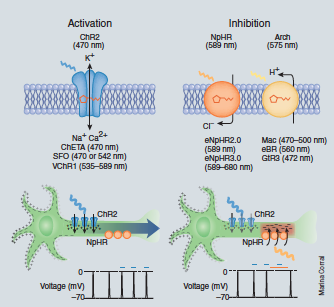CH391L/S14/ApplicationsofOptogenetics
From SynBioCyc
Introduction to Optogenetics
Optogenetics is a field of study that employs techniques from optics and genetics to control and study the functions of cells. In short, optogenetics involves the integration of extracellular genes to develop light sensitive proteins, strategies for targeted illumination, and finally, controlled readouts for reporting on changes in the cell.
A brief understanding of how optogenetics is applied; the 4 general steps for creating a light sensitive system:
- Step 1: Identify potential light sensitive proteins: Light sensitive proteins can be naturally occurring or chemically modified to become photosensitive. Photosensitive light proteins can be used to modulate membrane potential or modulate cell signaling. Examples will be provided later.
- Step 2: Delivering the genes: Genes coding these light sensitive proteins can be delivered to the target cells by transfection (deliberately inserting nucleic acids via non-viral techniques such as electroporation), viral transduction, or creation of transgenic animal lines.
- Step 3: Controlled illumination: Control of cellular activity depends on the well-defined temporal and spacial control of the illumination of light. There are several techniques for different desired effects. The 2012 Washington iGEM team designed a particularly useful app
- Step 4: Reading the outcome: The effect induced by illumination of the photosensitive proteins must be measured in cells, tissues, and organisms. For example, electrodes can be used to monitor effects of membrane voltage.
The basics of optogenetics can be found here, at a previously created page from 2013.
